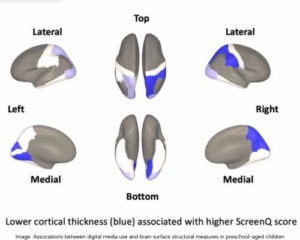Screentime and Children’s Health
Overexposure to Screens is Impacting Our Children's Health
Protective policy is urgently needed.
Increasing Screentime

Screen use in children and teens has escalated to unprecedented levels. In 2020, the American Academy of Child and Adolescent Psychiatry estimated that on average, children ages 8-12 in spend 4-6 hours a day watching or using screens, and teens spend up to 9 hours.
Social Media

A 2022 Pew Research Center survey found 35% of teens are “nearly constantly” on at least one of the top five social media platforms: YouTube, TikTok, Instagram, Snapchat, and Facebook. Yet research indicates that adolescents who spend more than 3 hours per day using social media may be at heightened risk for mental health problems,
Brain Changes

The largest long-term study of brain development and youth health in the U.S., the Adolescent Brain Cognitive Development (ABCD) Study, funded by NIH with 21 research sites across the country, analyzing brain scans of over 4,000 children who use electronic devices for seven hours or more each day have premature thinning of the brain cortex, the outer brain layer that processes information from the five physical senses (taste, touch, sight, smell and sound).
A 2022 Cincinnati Children’s hospital study also found differences in multiple brain regions associated with higher levels of digital media. These are just a few of the studies associating higher screen time with underdeveloped and altered brain development.
Science Finds Harm
Studies have found children’s excessive use of screens and digital media with a myriad of adverse effects including:
- Social: social skills, cyberbullying
- Psychological: depression, aggression, suicidal ideation, social emotional development, obsessive compulsive disorder
- Neurodevelopmental: cognitive development, visual motor, attention
- Physical: obesity, eye disease, metabolic syndrome, reduced sleep time
Children starting screens early in life (under two years old) is associated with speech and language delays.
Some scientists state the chronic sensory overstimulation of excessive screen time on brain development in youth will increase the risk of neurodegeneration and early onset dementia in in adulthood that will “result in widespread societal and economic distress” and “Preventative measures must be set in place immediately including investments and interventions in public education, social policy, laws, and healthcare.”
Protective Policy
International Cell Phone in School Bans
According to the 2023 UN report one in seven countries ban the use of mobile phones in schools.
Governments have banned cell phones in schools due to the impact on children’s learning range from England, France, Netherlands, Finland and Israel, China, Australia, Ontario and Greece to Ghana, Rwanda: and Uganda.
USA School Cell Phone Bans
According to the National Center for Education Statistics, in 2020, cellphone bans were in place in 76% of U.S. schools. Public schools and districts from Pennsylvania, Maine, and New York to Missouri, to California, have instituted various types of cell phone and digital device bans, generally citing the cell phones ability to distract students from learning goals.
Parent Teacher Organizations
Parents are organizing to support healthier screen use initiatives. In Maryland for example, the Montgomery County Parent Teacher Association passed a resolution to combat excessive screen time and learning loss by passing the nation’s first parent-led Digital Balance Resolution.
Read the Montgomery County PTA Resolution
School Cell Phone Bans Promote Learning
Research is finding school cell phone bans have a positive overall impact on academic attainment and student wellbeing. For example, research on two regions in Spain that banned phones in schools found significant reductions of bullying incidence as well as positive impacts on learning math and science.
Banning smartphones in Norwegian middle schools significantly increased girls’ grade point average improved their math test scores and increased their likelihood of attending an academic high school track.
A 2020 survey of 210 principals published in the Journal of the American Medical Association showed that more than 90 percent supported restricting students’ cell phones in school and 86 percent believed devices in the classroom harmed academic performance.

“We pediatricians, child psychiatrists and youth psychiatrists are concerned about the increase in the load on children's and young people's brains, which is increased by the constant use of digital devices (including mobile phones). We recommend that during the school day children are guaranteed the right to learn, normal interaction, and safe growth and development without excessive use of digital devices.”Statement of the Finnish Children's Medical Association, the Finnish Child Psychiatric Society and the Finnish Youth Psychiatric Society
Expert Recommendations to Minimize Screentime
U.S. Surgeon General Advisory
In late May, U.S. Surgeon General Vivek Murthy, MD, issued an advisory on social media and youth mental health, calling for technology companies to do better, policymakers to strengthen safety rules, and researchers to focus on the issue.
American Psychological Association
The American Psychological Association has issued a set of recommendations on social media use in youths that includes limiting harmful content and screening youth for “problematic social media use” that can impair daily life and risk serious psychological harms.
American Academy of Pediatrics
The American Academy of Pediatrics discourages media use by children younger than 2 and recommends limiting older children’s screen time to no more than one or two hours a day.
Resources
- American Academy of Pediatrics 2001
- American Academy of Pediatrics 2013.
- American Academy of Pediatrics 2016 Council on Communications and Media, Media and young minds. Pediatrics
United Nations
Unesco, the United Nation’s education, science and culture agency released a report in 2023 entitled “Global education monitoring report, 2023: technology in education: a tool on whose terms?” stating that there was scientific evidence that excessive mobile phone use was linked to reduced educational performance and that high levels of screen time had a negative effect on children’s mental health and emotional stability.
Canada
Canadian Paediatric Society guidelines highlight four principles – minimizing, mitigating, mindful usage and modelling healthy use of screens – to move away from screen time limits, which can be a major source of stress for parents and children.
United Kingdom
The United Kingdom, Royal College of Paediatrics and Child Health has published guidelines to help parents manage children’s screen time through dialogue.
-
There are numerous resources for parents and caregivers
- Be sure to check out ScreenTime Action Network- Fairplay and sign up for their News You Can Use updates
- Waituntil8th.org
- Screenstrong Families
- Center for Humane Technology
Experts
Movie Recommendations
Expert webinars
-
Barthorpe, A., Winstone, L., Mars, B., & Moran, P. (2020). Is social media screen time really associated with poor adolescent mental health? A time use diary study. Journal of Affective Disorders, 274, 864–870.
Boers, E., Afzali, M. H., Newton, N., & Conrod, P. (2019). Association of Screen Time and Depression in Adolescence. JAMA Pediatrics, 173(9), 853–859.
Bruni, O., Sette, S., Fontanesi, L., Baiocco, R., Laghi, F., & Baumgartner, E. (2015). Technology Use and Sleep Quality in Preadolescence and Adolescence. Journal of Clinical Sleep Medicine : JCSM : Official Publication of the American Academy of Sleep Medicine, 11(12), 1433–1441.
Carter, B., Rees, P., Hale, L., Bhattacharjee, D., & Paradkar, M. S. (2016). Association Between Portable Screen-Based Media Device Access or Use and Sleep Outcomes: A Systematic Review and Meta-analysis. JAMA Pediatrics, 170(12), 1202–1208.
Chau, K., Bhattacherjee, A., Senapati, A., Guillemin, F., & Chau, N. (2022). Association between screen time and culminating school, behavior, and mental health difficulties in early adolescents: A population-based study. Psychiatry Research, 310, 114467.
Chu, J., Ganson, K. T., Baker, F. C., Testa, A., Jackson, D. B., Murray, S. B., & Nagata, J. M. (2023). Screen time and suicidal behaviors among U.S. children 9–11 years old: A prospective cohort study. Preventive Medicine, 169, 107452.
COUNCIL ON COMMUNICATIONS AND MEDIA, Hill, D., Ameenuddin, N., Chassiakos, Y. (Linda) R., Cross, C., Radesky, J., Hutchinson, J., Levine, A., Boyd, R., Mendelson, R., Moreno, M., Swanson, W. S., & MBE. (2016). Media Use in School-Aged Children and Adolescents. Pediatrics, 138(5), e20162592.
COUNCIL ON COMMUNICATIONS AND MEDIA, Hill, D., Ameenuddin, N., Reid Chassiakos, Y. (Linda), Cross, C., Hutchinson, J., Levine, A., Boyd, R., Mendelson, R., Moreno, M., & Swanson, W. S. (2016). Media and Young Minds. Pediatrics, 138(5), e20162591.
Daniels, M., Sharma, M., & Batra, K. (2021). Social Media, Stress and Sleep Deprivation: A Triple “S” Among Adolescents. Journal of Health and Social Sciences, 6(2), 159–166.
Gioia, F., Rega, V., & Boursier, V. (2021). Problematic Internet Use and Emotional Dysregulation Among Young People: A Literature Review. Clinical Neuropsychiatry, 18(1), 41–54.
Heffler, K. F., Sienko, D. M., Subedi, K., McCann, K. A., & Bennett, D. S. (2020). Association of Early-Life Social and Digital Media Experiences With Development of Autism Spectrum Disorder–Like Symptoms. JAMA Pediatrics, 174(7), 690–696.
Hermawati, D., Rahmadi, F. A., Sumekar, T. A., & Winarni, T. I. (2018). Early electronic screen exposure and autistic-like symptoms. Intractable & Rare Diseases Research, 7(1), 69–71.
Hisler, G. C., Hasler, B. P., Franzen, P. L., Clark, D. B., & Twenge, J. M. (2020). Screen media use and sleep disturbance symptom severity in children. Sleep Health, 6(6), 731–742.
Horowitz-Kraus, T., & Hutton, J. S. (2018). Brain connectivity in children is increased by the time they spend reading books and decreased by the length of exposure to screen-based media. Acta Paediatrica (Oslo, Norway: 1992), 107(4), 685–693.
Hutton, J. S., Dudley, J., Horowitz-Kraus, T., DeWitt, T., & Holland, S. K. (2020). Associations Between Screen-Based Media Use and Brain White Matter Integrity in Preschool-Aged Children. JAMA Pediatrics, 174(1), e193869.
Junco, R., & Cotten, S. R. (2012). No A 4 U: The relationship between multitasking and academic performance. Computers & Education, 59(2), 505–514.
Kelly, Y., Zilanawala, A., Booker, C., & Sacker, A. (2018). Social Media Use and Adolescent Mental Health: Findings From the UK Millennium Cohort Study. EClinicalMedicine, 6, 59–68.
Law, E. C., Han, M. X., Lai, Z., Lim, S., Ong, Z. Y., Ng, V., Gabard-Durnam, L. J., Wilkinson, C. L., Levin, A. R., Rifkin-Graboi, A., Daniel, L. M., Gluckman, P. D., Chong, Y. S., Meaney, M. J., & Nelson, C. A. (2023). Associations Between Infant Screen Use, Electroencephalography Markers, and Cognitive Outcomes. JAMA Pediatrics.
Law, E. C., Han, M. X., Lai, Z., Lim, S., Ong, Z. Y., Ng, V., Gabard-Durnam, L. J., Wilkinson, C. L., Levin, A. R., Rifkin-Graboi, A., Daniel, L. M., Gluckman, P. D., Chong, Y. S., Meaney, M. J., & Nelson, C. A. (2023). Associations Between Infant Screen Use, Electroencephalography Markers, and Cognitive Outcomes. JAMA Pediatrics, 177(3), 311–318.
Lee, S., Kim, S., Yang, S., & Shin, Y. (2022). Effects of Frequent Smartphone Use on Sleep Problems in Children under 7 Years of Age in Korea: A 4-Year Longitudinal Study. International Journal of Environmental Research and Public Health, 19(16), 10252.
Lissak, G. (2018). Adverse physiological and psychological effects of screen time on children and adolescents: Literature review and case study. Environmental Research, 164, 149–157.
Luby, J., & Kertz, S. (2019). Increasing Suicide Rates in Early Adolescent Girls in the United States and the Equalization of Sex Disparity in Suicide: The Need to Investigate the Role of Social Media. JAMA Network Open, 2(5), e193916.
Madigan, S., Browne, D., Racine, N., Mori, C., & Tough, S. (2019). Association Between Screen Time and Children’s Performance on a Developmental Screening Test. JAMA Pediatrics, 173(3), 244–250.
Mireku, M. O., Barker, M. M., Mutz, J., Dumontheil, I., Thomas, M. S. C., Röösli, M., Elliott, P., & Toledano, M. B. (2019). Night-time screen-based media device use and adolescents’ sleep and health-related quality of life. Environment International, 124, 66–78.
Moreno, M. A. (2016). Media Use and Sleep. JAMA Pediatrics, 170(12), 1236.
Moreno, M. A., Jelenchick, L., Cox, E., Young, H., & Christakis, D. A. (2011). Problematic internet use among US youth: A systematic review. Archives of Pediatrics & Adolescent Medicine, 165(9), 797–805.
Mueller, P. A., & Oppenheimer, D. M. (2014). The pen is mightier than the keyboard: Advantages of longhand over laptop note taking. Psychological Science, 25(6), 1159–1168.
Nagata, J. M., Chu, J., Zamora, G., Ganson, K. T., Testa, A., Jackson, D. B., Costello, C. R., Murray, S. B., & Baker, F. C. (2023). Screen Time and Obsessive-Compulsive Disorder Among Children 9–10 Years Old: A Prospective Cohort Study. Journal of Adolescent Health, 72(3), 390–396.
Nagata, J. M., Cortez, C. A., Cattle, C. J., Ganson, K. T., Iyer, P., Bibbins-Domingo, K., & Baker, F. C. (2022). Screen Time Use Among US Adolescents During the COVID-19 Pandemic: Findings From
Onyeaka, H. K., Muoghalu, C., Baiden, P., Okine, L., Szlyk, H. S., Peoples, J. E., Kasson, E., Cavazos-Rehg, M. S. W. P., Firth, J., & Torous, J. (2022). Excessive screen time behaviors and cognitive difficulties among adolescents in the United States: Results from the 2017 and 2019 national youth risk behavior survey. Psychiatry Research, 316, 114740.
Ophir, E., Nass, C., & Wagner, A. D. (2009). Cognitive control in media multitaskers. Proceedings of the National Academy of Sciences, 106(37), 15583–15587.
Orben, A., Przybylski, A. K., Blakemore, S.-J., & Kievit, R. A. (2022). Windows of developmental sensitivity to social media. Nature Communications, 13(1), 1649.
Radesky, J. S., Kaciroti, N., Weeks, H. M., Schaller, A., & Miller, A. L. (2023). Longitudinal Associations Between Use of Mobile Devices for Calming and Emotional Reactivity and Executive Functioning in Children Aged 3 to 5 Years. JAMA Pediatrics, 177(1), 62–70.
Schoeni, A., Roser, K., & Röösli, M. (2015). Symptoms and Cognitive Functions in Adolescents in Relation to Mobile Phone Use during Night. PloS One, 10(7), e0133528.
Stiglic, N., & Viner, R. M. (2019). Effects of screentime on the health and well-being of children and adolescents: A systematic review of reviews. BMJ Open, 9(1), e023191.
Tamana, S. K., Ezeugwu, V., Chikuma, J., Lefebvre, D. L., Azad, M. B., Moraes, T. J., Subbarao, P., Becker, A. B., Turvey, S. E., Sears, M. R., Dick, B. D., Carson, V., Rasmussen, C., Investigators, C. study, Pei, J., & Mandhane, P. J. (2019). Screen-time is associated with inattention problems in preschoolers: Results from the CHILD birth cohort study. PLOS ONE, 14(4), e0213995.
Twenge, J. M. (2020). Why increases in adolescent depression may be linked to the technological environment. Current Opinion in Psychology, 32, 89–94.
Twenge, J. M., Haidt, J., Lozano, J., & Cummins, K. M. (2022). Specification curve analysis shows that social media use is linked to poor mental health, especially among girls. Acta Psychologica, 224, 103512.
Uhls, Y. T., Michikyan, M., Morris, J., Garcia, D., Small, G. W., Zgourou, E., & Greenfield, P. M. (2014). Five days at outdoor education camp without screens improves preteen skills with nonverbal emotion cues. Computers in Human Behavior, 39, 387–392.
Zhao, J., Yu, Z., Sun, X., Wu, S., Zhang, J., Zhang, D., Zhang, Y., & Jiang, F. (2022). Association Between Screen Time Trajectory and Early Childhood Development in Children in China. JAMA Pediatrics, 176(8), 768–775.

